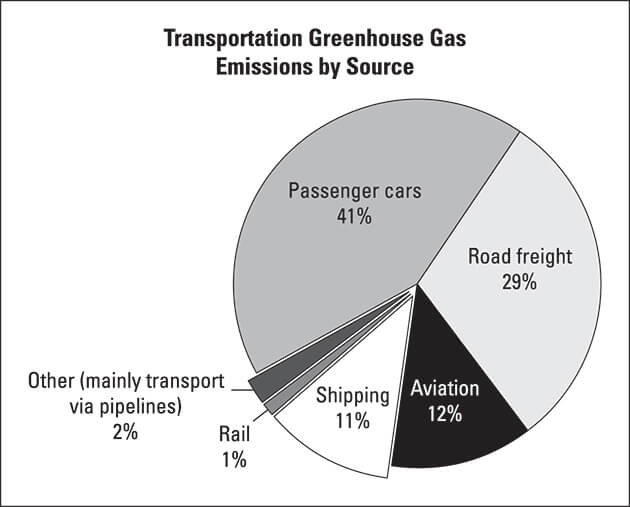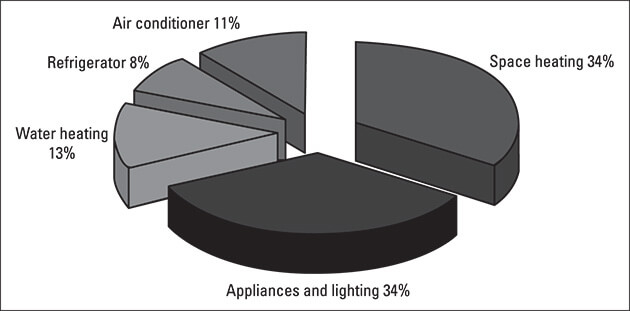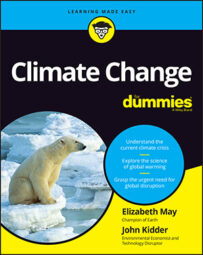Each of us uses energy — specifically, fossil fuels — on a daily basis:
- Electricity: From the moment the alarm sounds in the morning until you shut off the computer or TV at night, you’re connected to an electrical grid, often fueled by coal or oil.
- Transportation: Everyone needs energy to move from here to there — a steady supply of gas for your car or diesel fuel for the bus you ride to work.
- Food: Most of humanity’s food travels great distances before it arrives in homes, a journey it undertakes thanks to greenhouse gas (GHG)-producing fuels.
The COVID pandemic gave a real-life lesson in how much the individual is really to blame. For all of 2020, citizens everywhere around the world drove a whole lot less and flew hardly at all. You would have thought that GHGs would have dropped and in a big way. They dropped — but only by 6.4 percent, according to Nature.
And because of emissions in previous years, the concentration of GHGs in the atmosphere continued to rise, smashing through previous records to 412.5 parts per million (ppm) — more than at any time in more than 3 million years. Still, individual choices do matter.
The most powerful individual change you can make is political by letting your elected officials know you demand they take the climate emergency seriously. And the personal choices you make are important. They send a signal. They keep your own sense of personal choice and personal power intact.
How transportation impacts global warming
About 24 percent of all GHG emissions come from moving people and goods, according to the World Resources Institute. In the United States, the proportion is higher; closer to one-third of emissions come from transportation — 29 percent. In Canada, it’s 25 percent.Almost all transportation — about 95 percent, according to the Intergovernmental Panel on Climate Change (IPCC) — runs on oil-based fuels, such as diesel and gas. This explains why transportation accounts for such a large portion of overall emissions (electrification of transport is rising fast around the world, but it’s still only about 2.2 percent of all vehicles).
Cars and diesel trucks are the top two offenders, but ships, airplanes, trains, and buses play a part, too. We discuss the culprits of driving and flying in the following sections. The figure below shows the breakdown of how each mode of transportation contributes to GHG emissions.
 ©John Wiley & Sons, Inc.
©John Wiley & Sons, Inc.Passenger cars lead the way in terms of greenhouse gas emissions.
Driving emissions
Whether you need to run errands or drive the kids to soccer practice, cars, minivans, and SUVs are useful and often perceived as necessary. Most households in industrialized countries own at least one car because most cities and housing developments are built around road infrastructure — making it difficult to survive without one.However, that internal combustion engine now has serious competition — hybrid cars that generate energy to a battery to reduce fuel use and electronic vehicles (EVs), vehicles that run 100 percent on electricity.
These technologies promise to make the internal combustion obsolete, just as that technology disrupted the horse and buggy. In November 2021, Hertz, a major U.S. car rental company, placed an order for 100,000 Tesla EVs — that’s how fast things are changing.
Despite the pandemic, global sales of EVs increased by 43 percent in 2020. Still, even as sales of EVs and hybrids ramp up, in 2020 only 1 in 250 cars on the road is electric.
The majority of people in the developing world still don’t have access to a personal vehicle — but that’s quickly changing. China is soaring ahead in private car ownership, which jumped from 45 million cars in 2009 to more than 225 million in 2019! Total EV sales in China were 1.3 million, an increase of 8 percent compared to 2019. The 2019 sales of EVs in China amounted to 41 percent of all EVs sold worldwide.
Flying emissions
Planes burn fuel similar to kerosene, which gives off more emissions than the gasoline in your family car. The 2018 IPCC special report on 1.5 degrees found that aviation has grown to 14 percent of transport sector global carbon dioxide emissions.Not only does flying emit a lot of GHGs, it emits them in the atmosphere in a more damaging way. The warming impact of the exhaust from air travel is far worse than the same volume of GHGs emitted on the ground.
People made about 38.9 billion flights in 2019, and that dropped to less than 17 billion in 2020 due to the COVID pandemic. Still, it’s shocking that in 2007, globally, there were 4 billion individual plane trips for business or pleasure. And, even though flights dropped dramatically in 2020, they have started rising once again.
The people of China are flying more and exploring their own country by air and rail. They’ve also increased what is called outbound tourism — that is Chinese tourists exploring other countries. In 2003, 20 million tourists from China explored the world. By 2019, that figure was up to 155 million! China now tops the charts for outbound tourism.
Concern about the climate crisis is leading some countries to reduce flying. Impressively, the French government decided post-COVID that no domestic flights would be allowed where train travel was available.
Increasingly, climate-aware travelers work to eliminate air travel altogether. The pandemic allowed many organizations to experience meetings — big and small — using online video technologies.
The cost of flights and the wasted time traveling have likely made a permanent change in how employers see the practicality of video conferencing. This could increase the trend to staying home and avoiding flights wherever you can. If you have to fly, buying carbon offsets is a worthwhile option.
Energy uses around the house
In Canada and the United States, the floor space of the average home has continued to grow while family size is shrinking. House size has real implications for the climate crisis. The bigger the home, the more energy required to heat, cool, and light it. Fewer people are occupying — and heating and cooling — more space.When it comes to energy use in your home, you can think about it in two ways:
- Direct energy: This term refers to the energy you use, which comes from gas or fuel oil that you consume directly — such as the oil-fed heaters or propane gas stoves you may have in your home.
- Indirect energy: This term refers to how some other energy — oil, hydroelectric, wind, or nuclear power — is used to produce the direct energy. For example, natural gas is used to heat the oil sands enough so that the otherwise solid bitumen flows and can be extracted.
The energy that people use in their homes accounts for about 25 percent of GHG emissions around the world. Most of the fossil fuel energy you use directly goes toward heating your home. You use most of your electricity to power your lighting and appliances.
See the figure below for a complete breakdown of the percentages of GHG emissions produced from heating, lighting, and other energy uses.
 ©John Wiley & Sons, Inc.
©John Wiley & Sons, Inc.How you use your energy in your home
Your energy use may be very different than the average home. For example, you may not have an air conditioner.
When talking about climate change, scientists mean changes to the global climate systems. But people can also talk about “climate control” in their homes. Modern air conditioning can make the indoors feel like winter in a sweltering summer. Controlling the climate in your home can also impact the global climate system.
Controlling the climate in your home
Homes in the United States create 150 million metric tons of carbon dioxide every year from heating and cooling alone for 333 million people, according to the U.S. Department of Energy. That’s a full 2020 percent of U.S. GHG emissions. Check out the following sections for how heating and cooling your home plays a role in global warming.Heating
Heating takes either direct energy or electricity, depending on whether you have an oil or gas furnace or electrical baseboard heaters. Other types of home heating, such as wood stoves or gas fireplaces, also create emissions.The U.N Food and Agricultural Organization notes that burning wood for home heating (and in some countries, cooking, as well) accounts for about 6 percent of energy use in the world. Burning wood adds to GHG emissions both through the carbon dioxide released during burning and through deforestation.
Older furnaces emit more GHG than newer models. These old clunkers guzzle fossil fuels, but unfortunately, many homeowners cling to them, worried about the expense of buying a new unit. In reality, these homeowners can save money if they buy a new energy-efficient furnace, which would save them significantly on energy costs — and be less costly to the planet, too.
Cooling
Electricity used to be used only for keeping the lights on. Now, it’s what keeps people cool all summer long. In fact, the largest share of home electricity use now goes directly to air conditioning.And in places such as south central Canada, the greater share of power demand has recently shifted from winter to summer. With more 86 degrees F (30 degrees C) days every summer — thanks to global warming — the demand for air conditioning goes up annually.
Only industrialized countries used air conditioning, for the most part, until now. Recent news reports show that sales of home air conditioners have tripled in the last ten years in China.
As countries such as China and India move to catch up to industrialized countries, residents are starting to widely use luxuries such as air conditioning. Add warming temperatures into the mix, and you can see a growing air-conditioning trend and a growing demand for electricity to meet that desire.
Traditionally, most Europeans never considered air conditioning. But because killer heatwaves have ravaged Europe in recent years, this perspective is changing. For example, the U.K. had to consider new labor laws — in the past, laws ensured a legal minimum temperature so workers could stay warm enough. Because of intense summer heat, they’ve also had to consider legal maximum temperatures!
Perhaps the most surprising area to need air conditioning is in Canada’s far north. Buildings in the Northwest Territories and the Yukon are now being built with air conditioning. The average high temperature in the summer in those territories ranges from 70 to 80 degrees F (in the 20s C), but has been warming up recently and has reached the 90s F (about 30 degrees C).
Your food choices and global warming
Like a warm home in freezing weather, food is a necessity, not a luxury. But sadly, when people sought to make food more accessible and more convenient and to offer a greater variety, they often did so without considering the environmental toll their innovations might have.Much of the food that people buy at the grocery store uses a lot of energy to get there — and creates a lot of GHG emissions as a result. Here are some of the key offenders:
- Frozen food: Whether you’re talking refrigerated or frozen, these foods burn energy when they’re made, while they’re being transported, and even when they’re sitting in a freezer or cooler in the grocery store (or in your home). The most-energy-used-per-serving prize goes to freeze-dried coffee.
- Processed and packaged food: Moving these foods through the production line takes energy, as does making the packaging (not to mention the emissions that come from all that packaging when it ends up in a landfill).
- Food from afar: Elizabeth never even saw a kiwi until she was about 18 years old. Her daughter started asking for them for her school lunch in first grade. You may enjoy strawberries and mangoes in the dead of winter, when you can’t pick fresh fruit right in your backyard, but moving exotic fruits and veggies around the world by plane, ship, and truck has a real cost in energy. Could people afford them if companies factored in the cost to the climate? And why should your apple be more well-traveled than you?
- Meat products: Feeding livestock takes an average of 10 pounds of grain — grain that plays a large role in agricultural emissions — to produce 1 pound of meat. Also, when people eat more meat, more land is needed to raise livestock, which often means clearing forests and losing trees that breathe in our carbon dioxide.

